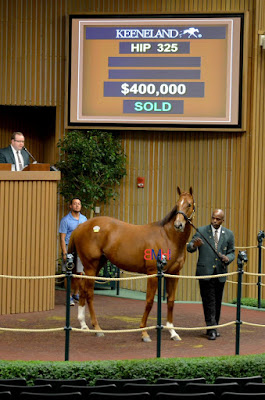Looking For Success: Yearling Vs. 2-Year-Old Sales Toppers
 |
| Carpe Diem was a $1.6-million 2-year-old |
From the beginning of the time when the commercial industry
took over as a major part of horse racing, some horses have brought millions of
dollars at a young age before it was known if they were anything more than well-bred,
big walking, well-built youngsters.
The yearling market is often the beneficiary of this
high-dollar trade with 58 million-dollar yearlings selling at the major
Keeneland and Fasig-Tipton sales from 2010 to 2014 with 12 of those horses
topping the sales. In that same time, the Fasig-Tipton Midlantic and Florida Sale, Keeneland,
and OBS 2-year-old sales had 12 horses sell for $1-million or more.
It’s well known that many horses who top the sales don’t
often live up to their price tag on the track, no matter what age they are but
digging farther into the data and looking at the sales toppers from 2010 to
2014 at both yearling and 2-year-old sales brought some interesting data to
light.
Looking at the 2-year-old sales toppers from the
Fasig-Tipton Midlantic, Fasig-Tipton Florida, OBS select and spring 2-year-old sales and the
Keeneland 2-year-olds in training sale (cancelled in 2015 but run during the
time frame of this study), 25 sales toppers averaged $937,800. Twenty-two of the
sales toppers raced with their average earnings sitting at $228,067.64 with 45
wins. Only five of those horses won graded stakes races (two won multiple Grade
1 races) but all but three horses made it to the track for at least one start.
2-YEAR-OLD SALES TOPPERS
Eight sales toppers sold for $1-million or more in
2-year-old sales with all but three making at least two starts. While two of them didn’t break their
maidens and one didn’t hit the board in his two career starts, a third (Giant
Causeway’s Carpe Diem) won four of his six races and ran in the 2015 Kentucky
Derby with Darwin (Big Brown) running at the group stakes level in Europe.
Looking at the yearling stats is a slightly different
picture.
The sales toppers from the Fasig-Tipton July Sale, Saratoga
Select and October Sales in addition to Keeneland’s September Sale were all
looked at. The 22 sales toppers from these sales brought an average of
$1,192,500 with 12 bringing over $1-million. Sixteen of the sales toppers made
it to the track with 20 wins between the 10 horses who have broken their
maidens for average earnings of $58,601.81 for the 16 horses. Surprisingly,
only one of the horses has won a stakes race, that coming from Mohaymen (Tapit)
in 2-year-old races this year.
YEARLING SALES TOPPERS
Of the sales toppers who sold for over $1-million, two have
never raced with one other just making one start in his career. One of the
horses who hasn’t started is a 2-year-old but the other is a 5-year-old with no
recent works. The 10 horses to races have made a combined 66 starts, winning 11
races and hitting the board 19 additional times.
It must be noted that the average earnings for the yearlings
will also trend a little lower than the 2-year-olds as a number of them have
been sold to European connections while the 2-year-old sales horses sold to
United States connections.
Not surprisingly, the bloodlines seen at the top of the
class in both the 2-year-old and yearling sales are fairly similar. The fairly
young A.P. Indy sire line is seen on the page of nine 2-year-old sales
toppers, the most of any sireline represented on the table, also taking the top
spot in the yearling table with seven toppers. While Tapit is the king of the
sales (and track) in America, only three toppers trace to A.P. Indy through him.
 |
| A.P. Indy in 2010 |
Mr. Prospector follows A.P. Indy with seven toppers coming
through his sire line, showing a surprisingly diverse choosing with only Smart
Strike having more than one sales topper on the combined charts. Danzig ties
Mr. Prospector in the second spot with his son War Front responsible for five
toppers having his sire line, son Hard Spun providing the sixth and grandson Big Brown the seventh.
Of the sales toppers damsires, quite a few stallions have
proven to be popular with both yearling and 2-year-old buyers interested in
horses out of their daughters. Again A.P. Indy leads the charge with Deputy
Minister, Carson City, Unaccounted For (two different foals out of the same
mare) and Wild Again also represented on both the yearling and 2-year-old lists.
Overall, if someone is willing to pay the money it takes to buy
a horse that will top a sale it looks like the 2-year-old sales are their best
bet. Not only is the risk of the horse getting injured before making it to the
track reduced by having one less year to worry about, but the top prices are
overall lower with higher average earnings.
Next week, All Equine All The Time will take a look at the
yearlings during the same time frame in the sales who brought $1-million or
more and what they have done so far on the track.




Comments
Post a Comment